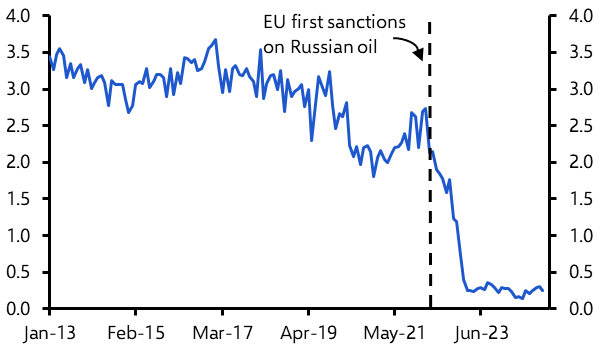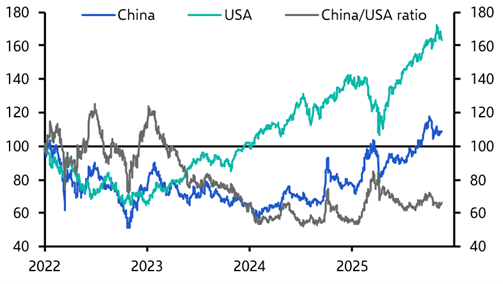Last week we held a conference in London in which we discussed the key issues facing the UK economy and financial markets in the next phase of Brexit. You can find all the presentations on our website. But from a macroeconomic perspective, three points are worth stressing.
The first is that, while the size of the government’s majority in parliament has strengthened its hand in negotiations with Brussels, Brexit uncertainty is likely to hang over the economy for at least the next year.
In the extreme, the UK may face yet another cliff-edge exit at the end of this year, when the transition period within the EU Withdrawal Agreement is due to expire. A more likely outcome, given the history of Brexit to date, is more fudge – with perhaps a “phase one” deal covering the basic elements of goods trade between the UK and EU agreed by the end of this year and the more thorny issues around services trade, market access and financial services kicked down the road. Whatever the outcome, however, the post-Brexit landscape will remain uncertain for a while, thus dashing any hopes of an imminent upswing in business investment.
A more plausible reason to expect an improvement in the UK’s economic performance this year stems from the second key point that we stressed in our conference, which is that fiscal policy is set to be loosened significantly. The exact scale of the stimulus will not be known until the Budget on 11th March. But we already know from September’s spending round that day-to-day government expenditure will increase by 0.6% of GDP in the fiscal year 2020-21. And the Conservative’s election manifesto suggests that an increase in public investment is also in the pipeline.
Putting all of this together, we think that fiscal policy will be loosened by around 1.0% of GDP over the next couple of years. What’s more, the nature of the stimulus is likely to be skewed towards the elements of government spending that deliver more bang for the buck in terms of economic growth (in the jargon, they have a higher “fiscal multiplier”).
Chart 1 illustrates this point by comparing the size of the stimulus we expect in the UK and its likely boost to economic growth, to that implemented by the Trump administration in the US in 2018. A large part of the Trump stimulus came from tax cuts that were tilted towards the upper end of the income distribution and carried a relatively low fiscal multiplier. In contrast, the UK stimulus is likely to have a large component of capital investment, which carries a high fiscal multiplier. The net result is a bigger impact on overall GDP growth.
Chart 1: Size & Effect of UK and US Fiscal Stimulus (% of GDP)

Admittedly, UK GDP growth is likely to remain relatively lacklustre, not least because of the continued headwinds from Brexit uncertainty discussed earlier. But we still think that looser fiscal policy should support a pick-up in growth from 1.0% this year to around 1.8% in 2021. If we’re right, that would be a bit better than most forecasters currently expect. It would also have a bearing on the third theme of our conference, which is the outlook for monetary policy.
The early weeks of this year have seen a remarkable repricing of the likelihood of interest cuts by financial markets. Just three weeks ago, markets put the probability of an interest cut at this Thursday’s MPC meeting at around 10%. By the start of last week, however, that had risen to 65%.
It goes without saying that the outcome of this Thursday’s meeting is on a knife-edge. Two out of nine MPC members voted for a cut in December. That may not sound like a big deal, but it’s worth noting that of the 12 previous instances when two members have voted for cuts, the MPC has subsequently loosened policy in 10.
However, we’re not convinced that a rate cut this month is as likely as the markets currently anticipate. December’s MPC meeting – and, indeed, dovish comments from several committee members since it – predate more recent data showing that the economy may be starting to find its feet. The past week has brought tentative signs that the housing market is improving, manufacturing is turning a corner and hiring is picking up. If that wasn’t enough then the flash PMIs for January, released on Friday, put the icing on the cake, with the composite manufacturing and services index jumping to its highest level since late 2018.
Taken together, we think this should be enough to dissuade the MPC from cutting interest rates this week. And, if we’re right, by the time the MPC next meets in March, the Budget will have happened and it will be able to factor full details of the impending fiscal stimulus into its forecasts. Accordingly, in contrast to the growing view in markets, we think interest rates will remain unchanged this week and throughout the course of this year.
There are three consequences of all of this for UK assets. First, if we’re right about the path of interest rates, then gilt yields are likely to edge up this year (our end-2020 forecast is 1.00% and our end-2021 forecast is 1.25%). Second, this should support a modest rise in sterling (our end-2020 forecast is 1.35/$ and our end-2021 forecast is 1.40/$). Finally, and most significantly, a combination of an improving economic backdrop and – in time – clarity over the post-Brexit policy and regulatory landscape should give a boost to UK equities. You can read more about all of this in our UK Markets service and our new Asset Allocation service. But without giving the game away, we suspect that the UK equity market will outperform most others in 2020-21.
In case you missed it:
- We’ve published several pieces outlining the economic and market risks stemming from the Wuhan virus. You can read an overview here and a detailed analysis of the implications for China here.
- Our Senior EM Economist, Jason Tuvey, argues that Turkey’s economic recovery rests on shaky foundations.
- Our China team has published its latest Outlook, which contains detailed economic and market forecasts and challenges the consensus in a number of important areas.



